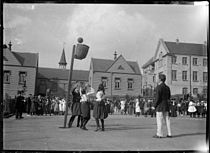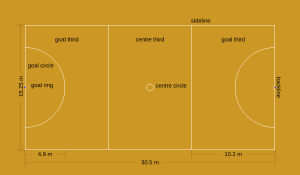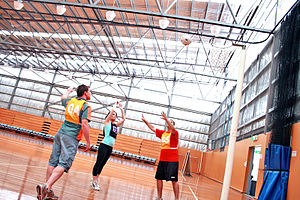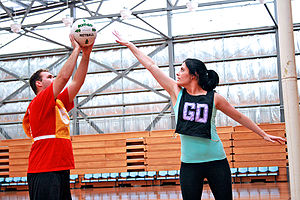
Netball
About this schools Wikipedia selection
This Schools selection was originally chosen by SOS Children for schools in the developing world without internet access. It is available as a intranet download. A good way to help other children is by sponsoring a child
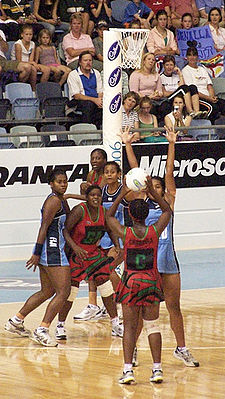 Malawi (red) playing Fiji (blue) at the 2006 Commonwealth Games. |
|
| Highest governing body | International Federation of Netball Associations |
|---|---|
| First played | Mid-to-late 1890s, England |
| Characteristics | |
| Contact | Limited |
| Team members | Seven on-court players per team |
| Mixed gender | Local competitions only |
| Categorization | Indoor or outdoor |
| Equipment | Netball |
| Olympic | No (IOC-recognised, 1995) |
Netball is a ball sport played between two teams of seven players. The sport shares many similarities with basketball, having been derived from early versions of women's basketball. It developed as a distinct sport in the 1890s in England, from where it spread to other countries. Netball is popular in Commonwealth nations and is predominantly played by women.
Games are played on a rectangular court divided into thirds, with a raised goal at each short end. The object of the game is for teams to score goals, by passing a ball and shooting it into the opposing team's goal. Players are assigned "positions" that define their role within the team and restrict their movement on court. During general play, a player with the ball can take no more than one step before passing it, and must pass the ball or shoot for goal within three seconds. Goals can only be scored by the assigned shooting players. Netball games are 60 minutes long, divided into 15-minute quarters, at the end of which the team with the most goals scored wins.
The sport is administered globally by the International Federation of Netball Associations (IFNA), and is reportedly played by over 20 million people in more than 70 countries. Local-level participation is widespread in Commonwealth nations, particularly in schools, although international competition and domestic leagues only receive substantial recognition in a few countries. The highest level of international netball includes the Netball World Championships, the netball event at the Commonwealth Games, and the World Netball Series.
History
Origins from basketball
Netball emerged from early versions of women's basketball, evolving with the increasing participation of women in sport. Basketball was invented in 1891 by James Naismith, a Canadian physical education instructor working in Springfield, Massachusetts. His new game was played in his school's gymnasium between two teams of nine players, using an association football that was shot into closed-end peach baskets. Senda Berenson, a teacher at a nearby women's college, developed women's basketball the following year, with modified rules designed to accommodate the social norms regarding appropriate conduct and attire for women, and contemporary notions on their limited physical capacity.
Women's basketball spread across the United States over the next few years, with many variations arising in different parts of the country. In 1893, Clara Gregory Baer introduced her own version of the sport to her female students in New Orleans. Two years later, she released the first published rules for women's basketball, which she called " basquette". Baer's game was substantially different to Berenson's, but was similarly designed to facilitate women's participation in sport. The first unified rules of women's basketball was published by Berenson in 1901, which included a number of rules from Baer's game. The rules of women's basketball eventually merged with those of the men's game, although these early versions of women's basketball gave rise to another sport: netball.
Early development of netball
Basketball spread to England within a few years of its invention. Martina Bergman-Österberg introduced one version of basketball in 1893 to her female students at her Physical Training College in London (later in Dartford). Subsequent revisions were made at the college two years later, and in 1897 rules were introduced from women's basketball in the United States. By that time, the game had moved outdoors and the baskets were replaced by rings that had nets; Madame Österberg's sport had also acquired the new name "net ball". The first codified rules of netball were published in 1901 by the Ling Association (later the Physical Education Association of the United Kingdom). From England, netball spread to other countries in the British Empire. Variations of the rules and even names for the sport arose in different areas: "women's (outdoor) basketball" arrived in Australia around the start of the 20th century and in New Zealand from 1906, while "netball" was being played in Jamaican schools by 1909.
Netball became a popular women's sport in countries where it was introduced, and spread rapidly through school systems. School leagues and domestic competitions emerged during the first half of the 20th century, and in 1924 the first national governing body was established. International competition was initially hampered by a lack of funds and varying rules in different countries. Australia and New Zealand contested the first international game of netball in Melbourne on 20 August 1938, which the host nation won 40–11. Efforts began in 1957 to standardise netball rules globally: by 1960 international playing rules had been standardised, and the International Federation of Netball and Women's Basketball (later the International Federation of Netball Associations) was formed to administer the sport worldwide.
The global game
In 1963, the first international tournament was held in Eastbourne, England; this was originally called the World Tournament, and eventually became known as the Netball World Championships. It has been held every four years since, most recently in 2007. The World Youth Netball Championships started in Canberra in 1988, and have been held roughly every four years since. In 1995, netball became an Olympic-recognised sport, allowing its inclusion in future games. Three years later it debuted at the Commonwealth Games in Kuala Lumpur. Other international competitions also emerged in the late 20th century, primarily contested between second- and third-tier netball nations: these include the Nations Cup and the Asian Netball Championship.
School leagues and nationwide club competitions have existed in countries such as England, Australia, New Zealand and Jamaica since the early 20th century. However, franchise-based netball leagues only emerged in the late 1990s. The most prominent of these competitions are the ANZ Championship in Australia and New Zealand, and the Netball Superleague in the United Kingdom. These competitions sought to increase the profile of the sport in their respective countries, which despite widespread local-level participation remains largely amateur. In 2008, efforts were started to include netball in the Olympic Games from as early as 2012. A new format of the game, called fastnet, was also announced in December that year, one that featured shorter matches with modified rules designed to make the game more appealing to spectators and television audiences.
Description and rules
Objective
The objective of a game of netball is for players to pass the ball to a teammate within the opposition's goal circle and score goals, which the opposing team will attempt to prevent. The team with the most goals at the end of a game is the winner.
Court and its dimensions
Like basketball, netball is played on either a hard or soft court with scoring hoops or "rings" at both ends. The court is slightly larger than a basketball court, being 30.5 m long and 15.25 m wide. The longer sides are called "side lines" and the shorter sides are called "goal lines"or "back lines". Court markings are no more than 50 mm wide. The court is divided into thirds which regulate where individuals of each position are allowed to move. A 90 cm-diameter "centre circle" is located in the centre of the court. At each end of the court there is a 4.9 m-radius semi-circular "shooting circle" or "goal circle" from within which all scoring shots must be taken. The goal posts are 3.05 m high from the top of the ring to the ground and have no backboards. The rings have an internal diameter of 380 mm and are located 150 mm forward from the post and are made of 15 mm diameter steel. The height is the same as a basketball hoop, but in netball the diameter of the rings is 3 inches smaller. It is possible to play netball using a basketball hoop but if there is any contact between the ball and the backboard, the ball is considered out of play. If a goal is scored off the backboard it does not count. Some versions of the rules allow a goal to be scored from a backboard rebound if a player who can catch the ball throws the ball in without touching the ground.
Ball
The ball resembles a basketball but is lighter, smaller, slightly softer in construction, and generally white. A netball will often have patterns engraved or stitched into its design similar to a volleyball. Gilbert is the official ball supplier of the International Federation of Netball Associations.
Positions
There are seven players on each team, who are given nominated, named positions (some junior/training variants have only five players per team, and the indoor short version has 6 players). Each player must wear a "bib" showing one of the abbreviations below, indicating that player's position. Each player is only allowed in certain areas of the court: a player in a section of court that is not part of their playing area is deemed "offside". The positions are described below:
| Position Name | Abbreviation | comments |
|---|---|---|
| Goal Shooter | GS | This player must get past the Goal Keeper of the other team. He or she can move within the "attacking" goal third, including the shooting circle. |
| Goal Keeper | GK | This player must stop the GOAL SHOOTER from scoring. He or she can move within and across the defensive goal third and the shooting circle. |
| Goal Attack | GA | This player acts as the "goal attack," and can move within and across the "attacking" goal third, shooting circle, and centre third areas. |
| Goal Defence | GD | This player must protect against the GOAL ATTACK player, and can move within and across the "defensive" goal third and centre third, as well as within the shooting circle. |
| Wing Attack | WA | This player functions as the "wing attack," and can move within and across the "attacking" goal third and centre third, but not in the shooting circle. |
| Wing Defence | WD | This player"s function is to "defend" the wing areas, so he or she can move within and across the "defensive" goal third and centre third, but never in the shooting circle. |
| Centre | C | This player can move in all areas except the shooting circles. |
Scoring goals
By the combination of the above, only the Goal Attack and Goal Shooter are able to score goals directly, and this may only be done from the inside of the circle. The job of the Goal Defence and Goal Keeper is to block the Goal Attack and Goal Shooter from shooting; however, they must be three feet or more away from the landing foot of the shooter, otherwise it is called an obstruction. In this, the Goal Keeper or Goal Defence must stand by the shooter's side for a penalty pass or shot and are now not allowed to block. A ball that passes through the hoop, but has been thrown either from outside the circle or by a player not the GA or GS, is deemed a "no goal". Furthermore, a shooter (GA or GS) may not shoot for a goal if a "free pass" has been awarded for an infringement such as stepping, offside, or using the post.
If a player misses and the ball does not touch the rim or any part of the post, the player cannot catch it otherwise it is called replay. This results in a free pass to the other team.
Starting and restarting play
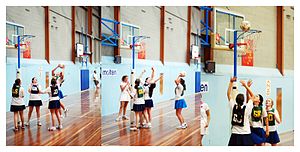
At the beginning of every quarter or after a goal is scored, play starts from the centre of the court with a "centre pass". These passes alternate between the teams, regardless of which team scored the last goal. A centre pass is made by a player in the "centre" position who must have one foot grounded within the centre circle. As the game restarts, only the player in the 'Centre' position from each team are allowed in the centre third of the court. When the umpire blows the whistle to restart play, players in the positions "Goal Attack", "Goal Defence", "Wing Attack" and "Wing Defence" can move into the centre third, where the centre pass must be caught.
If the ball touches the ground outside the court boundaries, then a member of the team that was not the last to touch the ball before it went out is able to throw the ball back into the court to restart play.
Stepping, footwork, and passing
Netball rules do not permit players to let their landing foot touch the ground again if it is lifted at all while in possession of the ball, so players can take 1.5 steps while holding the ball. Players are entitled to balance on the other foot if the landing foot is lifted. Consequently, the only way to move the ball towards the goal is to throw the ball to a team-mate. The ball can be held by a player for less than three seconds at any time. A player may tap (deflect) the ball let it bounce and then take possession and throw it. The player cannot catch the ball (with both hands), drop it and pick it up again; this is called a replayed ball. The duration before it is called a drop is determined by the umpire. These rules, combined with the restrictions on where one player of a particular position can move, ensure that everyone on the team is regularly involved in play.
Contact and obstruction
Contact is only permitted provided it does not impede with an opponent or the general play and players must be at least three feet (90 centimetres) away from a player with the ball while attempting to defend. If impeding contact is made, a penalty is given to the team of the player who was contacted, and the player who contacted must stand "out of play", meaning they cannot participate in play until the player taking the penalty has passed the ball.
Playing time
A game is played in four quarters, each one lasting fifteen minutes, with intervals of three minutes between the first and second quarters, and between the third and fourth quarters. There is also an interval of five minutes at half time. If a player/umpire calls time, and the time keeper pauses the timer. When the game starts and the player has swapped places with another player, or is healthy, play is resumed and the timer is restarted.
Variations
Indoor netball
Indoor netball is a variation of netball, played exclusively indoors, in which the playing court is surrounded on each side and overhead by a net. The net prevents the ball from leaving the court, reducing the number of playing stoppages. This gives indoor netball a faster pace than netball. In places where indoor netball courts are not available, this version of the game can be played in a smaller hall (such as a school gymnasium) using the walls instead of a net. This version of the game is played with 6 players; 2 Attacks, 2 Centres and 2 Defence. The Attacks and Defence can each go in one half of the court including the goal circle, while the centres can play in the whole court except the goal circle. A unique feature of this form of the game is that players can shoot from outside the goal circle for a 2 point goal, while shots taken inside the goal circle still earn 1 point.
Fastnet
Fastnet is a variations on the rules of netball designed to make games faster and more television-friendly. It is employed in the World Netball Series with the ultimate aim of raising the sport's profile and attracting more spectators and greater sponsorship. The modified rules are outlined below.
- Timing: Each quarter lasts only six minutes, compared with 15 minutes in normal international netball competition. Breaks in between quarters are two minutes each. Injury time-outs are 30 seconds only; standard rules allow for one initial two-minute injury time-out.
- Coaching: Coaches can give instructions to players from the sidelines during play, from in front of their playing bench. Standard international rules do not allow coaching during play.
- Substitutions: As in basketball, teams will be allowed to use rolling substitutions, with no stoppages in play per substitution and with unlimited substitutions per quarter. Standard international rules only allow substitutions either between quarters or when a player is injured.
- Power plays: Each team can separately nominate one "power play" quarter, in which each goal scored by that team counts for double points. This is somewhat similar to powerplays in One Day International and Twenty20 cricket, although it is not a feature of standard netball.
- Two-point shots: Similar to three-point field goals in basketball and two-point goals in six-a-side indoor netball, the goal shooter (GS) and goal attack (GA) may shoot goals from outside the shooting circle. These goals count for two points; in a power-play quarter, they would count for four points. Umpires raise one arm for a single-point goal and two arms for a two-point goal. In standard netball rules, goals can only be shot from within the shooting circle and count for one point only.
- Centre passes: After each goal, the team that conceded the goal takes the next centre pass; teams alternate taking the first centre pass of each quarter. Under normal rules, a coin toss determines the first centre pass of the match, after which centre passes alternate between the two teams.
- Tied scores: Ties will be decided by penalty shoot-outs, similar to those in association football. Often in competitive netball, tied games simply continue until one team wins in extra time, or else subsequently achieves a two-goal advantage.
Worldwide popularity
Netball is a popular participant sport, particularly in countries of the Commonwealth of Nations such as Australia, South Africa, New Zealand, Malawi, Jamaica, Zambia and the United Kingdom. Over 20 million people play netball in more than 70 countries. Netball is commonly played by Commonwealth children during their years at school.
Oceania
In Australia and New Zealand, netball is one of the most popular sports played by women. The ANZ Championship is a Trans-Tasman semi-professional competition that has been broadcast on television in both New Zealand and Australia since 2008.
West Indies
Approximately 10,000 people play netball in Jamaica, and it remains the favoured women's sport in that country. Antigua and Barbuda is also very active in the netball, with cricket being the only sport more popular.
Physical appeal
Netball requires speed, strategy, team work and co-ordination, thus its appeal is not limited to women. Representative men's teams exist, but attract less attention. At primary home level, mixed teams are not uncommon. As adults, men and women can compete with each other on reasonably fair terms as the restrictions on defence, limitations of numbers and positions of male players, and the women's greater familiarity with the game, prevent those men of superior strength and size gaining an overly large advantage.
Major competitions
Netball World Championships
The most important competition in netball is the Netball World Championship which is held every four years. The Australian Netball Diamonds are the current world champions having won the 2007 Championship in New Zealand. Past winners include the Silver Ferns of New Zealand and joint 1979 winner the Calypso Girls of Trinidad and Tobago, though England, the Proteas of South Africa and the Sunshine Girls of Jamaica have all also placed.
World Netball Series
The World Netball Series is an international netball competition which was contested for the first time in October 2009. The new competition features Fastnet rules (which has been likened to Twenty20 cricket and rugby sevens). The competition is scheduled to be held annually in Manchester, England until at least 2011, and will be contested by the six top national netball teams in the world, according to the IFNA World Rankings.
World Youth Netball Championships
Australia beat the Silver Ferns to win the World Youth Netball Championships in July 2009 in the Cook Islands. The 2005 Youth Championship was held in Miami, Florida and was won by New Zealand.
Commonwealth Games
As netball is popular in the Commonwealth, it has been included in the Commonwealth Games since 1998. Australia have taken gold home twice since then, the Silver Ferns of New Zealand also on two occasions (including the recent 2010 Games held in India). England and Jamaica are the two other teams that have placed.
Asian Netball Championship
The Asian Netball Championship is a competition held between Asian countries. It occurs every four years. The winners in 2009 were the Sri Lankan team, with a win over the Singaporean team with a score of 77-48 in the final.
South Pacific Games
Netball is one of the sports at the Pacific Games (formerly known as the South Pacific Games). The Pacific Games is a multi-sport event, much like the Olympics, (albeit on a much smaller scale), with participation exclusively from countries around the South Pacific. It is held every four years and began in 1963.
The Nations Cup
The Nations Cup (also known as the 4 Nations Netball Cup, the 5 Nations Netball Cup) is an international organised by Netball Singapore. In 2007, the competition included the Singapore national netball team, Canada, Northern Ireland, Sri Lanka and Trinidad & Tobago. The 2008 Nations Cup will be between the Botswana national netball team, Barbados, Northern Ireland, the Samoa national netball team and Singapore.
ANZ Championship
The ANZ Championship is the elite netball competition contested between five teams each from both Australia and New Zealand. It began in April 2008, succeeding Australia's Commonwealth Bank Trophy and New Zealand's National Bank Cup as the highest level of competitive netball in those countries. The 2010 champions are the Adelaide Thunderbirds.
Domestic competitions
Australasia
- Commonwealth Bank Trophy - Australia (to 2007)
- Fisher and Paykel Series
- National Bank Cup - NZ (to 2007)
Great Britain
- The Super League
Singapore
- Netball Super League
Australian variations for children
Fun Net
Fun Net is Netball Australia's play based motor skills program for 5-7 year olds. The emphasis is on the acquisition of basic motor skills, in a fun environment of games and activities. The length of the Fun Net program can be run between 8–16 weeks, although this is flexible depending on school, association and individual needs. The goal posts are only 2.4m high and a smaller size 4 netball is used.
Netta
Netta is a basic introduction into the professional aspect of netball for children aged seven years or older. A size 4 ball is used to develop correct passing and catching skills with up to six seconds allowed between catching and passing the ball, instead of the three seconds permitted in the adult game. All players rotate positions throughout the game so that they can experience the differences between each position. The program of Netta allows children to acquire important skills necessary in the game of netball in a fun and exciting environment. The aim of Netta is to ensure each child leaves with the confidence and skills ready to play Netball.
High Five
High five netball ensures that children gain experience at all positions on the court. There are five positions and the players must swap around these positions during the game, allowing them to try out every position. High Five has also been adopted by a number of adult mixed and ladies social netball leagues in London and is known as "versatility"
